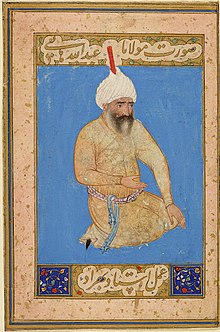Hatefi
This article needs additional citations for verification. (August 2011) |
'Abd-Allah Hatefi | |
|---|---|
 Portrait of Hatefi by Kamal ud-Din Behzad | |
| Born | 1454 Jam, Afghanistan |
| Died | 1521 |
| Occupation | Persian Poet |

Hatefi, 'Abd-Allah (Template:Lang-fa) was a Persian poet (1454–1521) and nephew of Abdul Rahman Jami.[1]
Life
He was born around 1454 at Khargerd, a village on the outskirts of the Khorasanian town Jam (modern Afghanistan). He spent his whole life in his native city and served as the custodian of the Qasim Anvar museum. He entered Timurid literary circles after passing a test that was set up by his uncle, the famous Persian poet 'Abdul Rahman Jami. Hatefi was a Shi'ite and was thus honored by Shah Ismai'l the founder of the Safavid dynasty. He interceded on behalf of the Sunni inhabitants of Jām towards whom this Safavid ruler was hostile.
Works
Hatefi composed poetry in several genre but he is known above all for his Khamsa (pentalogue). Modelled after previous petanologues of Persian literature including those of Nizami Ganjavi, his Khamsa became famous even outside of Iran. Lami'i Chelebi, produced an Ottoman translation of his work, and the several editions of his Khamsa in the Ottoman Empire and in India are proof of his widespread fame. Hatefi's literary fame rests on his realistic and straightforward style.[1] He displayed a remarkable originality in handling his stories with his style often emulated by later poets.[1] Four of his works in his Khamsa have been published thus far.
The five works which are comprised by his Khamsa are:
- Layli o Majnun
- Shirin o Khosrow
- Haft manzar
- Zafar-nama
- Fotuhat-e shahi
See also
References
- ^ a b c Michele Bernardini, Hatefi, Encyclopedia Iranica.
